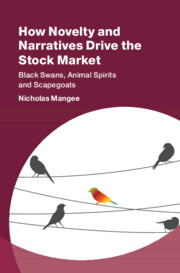Book contents
- Frontmatter
- Dedication
- Contents
- List of Figures
- List of Tables
- Preface
- Acknowledgments
- PART I NOVELTY, NARRATIVES, AND INSTABILITY
- PART II NEWS ANALYTICS AS A WINDOW INTO STOCK MARKET INSTABILITY
- 4 News Analytics: Novelty, Narratives, and Nonroutine Change
- 5 The Corporate Knightian Uncertainty Index
- 6 KU Sentiment, Novelty, and Relevance
- 7 Diversity of Corporate Uncertainty Events
- 8 Macro versus Micro Novelty
- PART III EMPIRICAL EVIDENCE FOR THE NOVELTY-NARRATIVE HYPOTHESIS
- Appendix A R Code for Bloomberg News Word Cloud and Histogram
- Appendix B The Bloomberg News KU Stock Market Project
- Appendix C RavenPack Terms for Event Output Record
- Appendix D Unscheduled Events from RavenPack
- Bibliography
- Index
8 - Macro versus Micro Novelty
from PART II - NEWS ANALYTICS AS A WINDOW INTO STOCK MARKET INSTABILITY
Published online by Cambridge University Press: 23 September 2021
- Frontmatter
- Dedication
- Contents
- List of Figures
- List of Tables
- Preface
- Acknowledgments
- PART I NOVELTY, NARRATIVES, AND INSTABILITY
- PART II NEWS ANALYTICS AS A WINDOW INTO STOCK MARKET INSTABILITY
- 4 News Analytics: Novelty, Narratives, and Nonroutine Change
- 5 The Corporate Knightian Uncertainty Index
- 6 KU Sentiment, Novelty, and Relevance
- 7 Diversity of Corporate Uncertainty Events
- 8 Macro versus Micro Novelty
- PART III EMPIRICAL EVIDENCE FOR THE NOVELTY-NARRATIVE HYPOTHESIS
- Appendix A R Code for Bloomberg News Word Cloud and Histogram
- Appendix B The Bloomberg News KU Stock Market Project
- Appendix C RavenPack Terms for Event Output Record
- Appendix D Unscheduled Events from RavenPack
- Bibliography
- Index
Summary
This chapter explores higher order relations between overarching narratives and subnarratives coursing through the stock market, that is, between macro unscheduled and micro unscheduled events. The macro KU events data from Dow Jones financial news is introduced. First, the absolute count of unscheduled macro events reported for the USA is dwarfed by their micro KU counterparts. Second, the macro KU indices share many of the same internal relationships as the corporate KU indices. Both KU macro and micro count data display similar signs of correlations between their associated ESS, relevance, and ENS scores suggesting that both narratives and subnarratives may have a common internal framework. Third, sentiment, relevance, novelty, and inertia indices for macro and micro events are interacted through principal components analysis to create KU micro and macro “narrative” series. The comovement of the two new variables over time is striking that suggests that macro narratives and micro subnarratives are positively related. The fourth key finding is that there is strong statistical evidence of “causality” only in the direction from macro KU events to corporate KU events.
- Type
- Chapter
- Information
- How Novelty and Narratives Drive the Stock MarketBlack Swans, Animal Spirits and Scapegoats, pp. 202 - 222Publisher: Cambridge University PressPrint publication year: 2021



